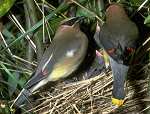Surfin' the Food Web
 A successful ecosystem
depends on the exchange of energy between organisms. This energy is passed on from individual to individual via feeding. Different
species are grouped together based on what they eat, and these groupings are called
trophic levels. A successful ecosystem
depends on the exchange of energy between organisms. This energy is passed on from individual to individual via feeding. Different
species are grouped together based on what they eat, and these groupings are called
trophic levels.
There are four basic trophic levels, but it is possible to have five or six as well. In the bottom level are the
producers, and then come the herbivores, the
carnivores, and the detrivores. All of these levels exchange life-giving energy.
 Different trophic levels both give and take energy from one another in a linkage referred to as a
food web or food
chain. Food webs are very complex, and even biologists have yet to
understand all the dynamics and interactions in food webs. A simplified version of a food web would function like this: plant grows, animal eats plant, animal eats animal who ate plant, both animals and plants die, and are in turn eaten by smaller organisms, who convert this organic material back into
organic compounds in soil that can be taken up again by plants. Different trophic levels both give and take energy from one another in a linkage referred to as a
food web or food
chain. Food webs are very complex, and even biologists have yet to
understand all the dynamics and interactions in food webs. A simplified version of a food web would function like this: plant grows, animal eats plant, animal eats animal who ate plant, both animals and plants die, and are in turn eaten by smaller organisms, who convert this organic material back into
organic compounds in soil that can be taken up again by plants.
There are two types of food webs that make up the
larger, more general definition of food webs: grazing webs and
detritus webs.
[Detritus
Food Webs][Grazing Food Webs][Biomass]
[The Importance of all Creatures][Species
Relationships]
|
 Heritage Community Foundation Presents
Heritage Community Foundation Presents










